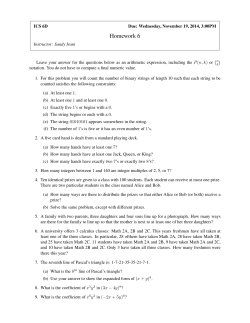
Apr 6 - Illinois Institute of Technology
Illinois Institute of Technology Lab 6 LC-3 Programming CS 350: Computer Organization & Assembler Language Programming Lab 6, due Fri Apr 3 Tue Apr 7 * A. Why? • The LC-3 and similar architectures are representative of simple instruction set architectures. • Writing low-level programs illustrates what low-level hardware does and how compilers and interpreters work. B. Outcomes After this lecture lab, you should be able to: • Translate pseudocode into programs in LC-3 assembler. • Write short assembler programs to do calculations and searches. C. Programming Problems [100 points total] Note: Take your *.asm files, zip them together, and submit the zipped file through Blackboard. (Don’t include the *.obj, etc. files or runs of the programs.) Be sure to put your name inside each asm file. For each program, up to roughly 30% of the credit is for good commenting. At the top of each program file, say what the program does. Also, say what registers are holding which values and what the relationships are between those values. In the program itself, include line comments to say what you’re doing (in higher-level terms if you can: “; count++” is better than just “; R0++”). Problem 1 [40 pts] Write an LC-3 program that left-shifts a value from one word to another: We save the bits that are shifted out of the first word and store them into a second word. For example, if we shift X = 1111 1111 1111 1111 left five places, then we have * No extension to Apr 8 CS 350: Comp Org & Asm Pgm’g –1 – © James Sasaki, 2015 Illinois Institute of Technology Lab 6 two words of results: R = 1111 1111 1110 0000 (the bits remaining after shifting) and L = 0000 0000 0001 1111 (the bits that were shifted out). Your program should have labels X, L, R, and N. Running the program should left-shift the value in X by N positions and save the results into locations L and R. The labels don't have to be declared in the order shown below, and you can declare extra labels and variables if you like. As an example, say we start with X! N! R! L! .FILL! xFFFF .FILL! 5 .BLKW! 1 .BLKW! 1 Then at the end, L and R should contain x001F and xFFE0 don't read in X and N; they're hard-coded into the program. on different X and N, you'll have to modify their declarations rerun the program. Also, you don't have to check for 0 ≤ N ≤ respectively. Note you To test your program and re-assemble and 16. Here’s some pseudocode. (Use registers to hold L, R, and I as you manipulate them; store L and R in their labeled memory locations when you're done.) L ← 0 R ← X I ← N (I = the number of shifts yet to do) while I > 1 Left-shift L one bit with zero fill Inspect the leftmost bit of R if the leftmost bit of R is 1 Set the rightmost bit of L to 1 Left-shift R one bit with zero fill --I end while Store L into memory Store R into memory Hints: • Each line of pseudocode above corresponds to one LC-3 instruction. • To left-shift a value one bit with zero fill, multiply it by 2. • The leftmost bit of a value is 1 iff the value is negative. CS 350: Comp Org & Asm Pgm’g –2 – © James Sasaki, 2015 Illinois Institute of Technology Lab 6 Grading scheme: Each line of pseudocode above is worth roughly 2 to 4 points depending on its difficulty. Commenting / documentation is worth 12 points. Problem 2 [60 points] Write an LC-3 program that reads a character and a string and counts the number of occurrences of the character in the string. If the count is 9 or less, print out the count; if the count is 10 or more. For example, the LC-3 console might look like this: (user input is underlined; “↵” means carriage return). Note the string can contain spaces. Char to search for: e String to search through: alphabee tz!? #QZ&↵ The count was 5 Here’s some pseudocode for the program: Print a prompt for a character s to search for Read it in and echo it back out Initialize count = 0 Print a prompt for a string Read a character c and echo it while c ≠ line feed ! if c = s then ++count ! read next value of c and echo it end loop if count ≤ 9 ! Convert the count to an ASCII character ! Print the count to the monitor else ! Print "There were more than 9 occurrences" halt Technical note: Why ≤ 9 occurrences? Because otherwise you’d have to convert an arbitrary integer into a string of digits, which is painful. Grading scheme: Each line of pseudocode above is worth roughly 2 to 4 points depending on its difficulty. Commenting / documentation is worth 12 points. CS 350: Comp Org & Asm Pgm’g –3 – © James Sasaki, 2015
© Copyright 2025










